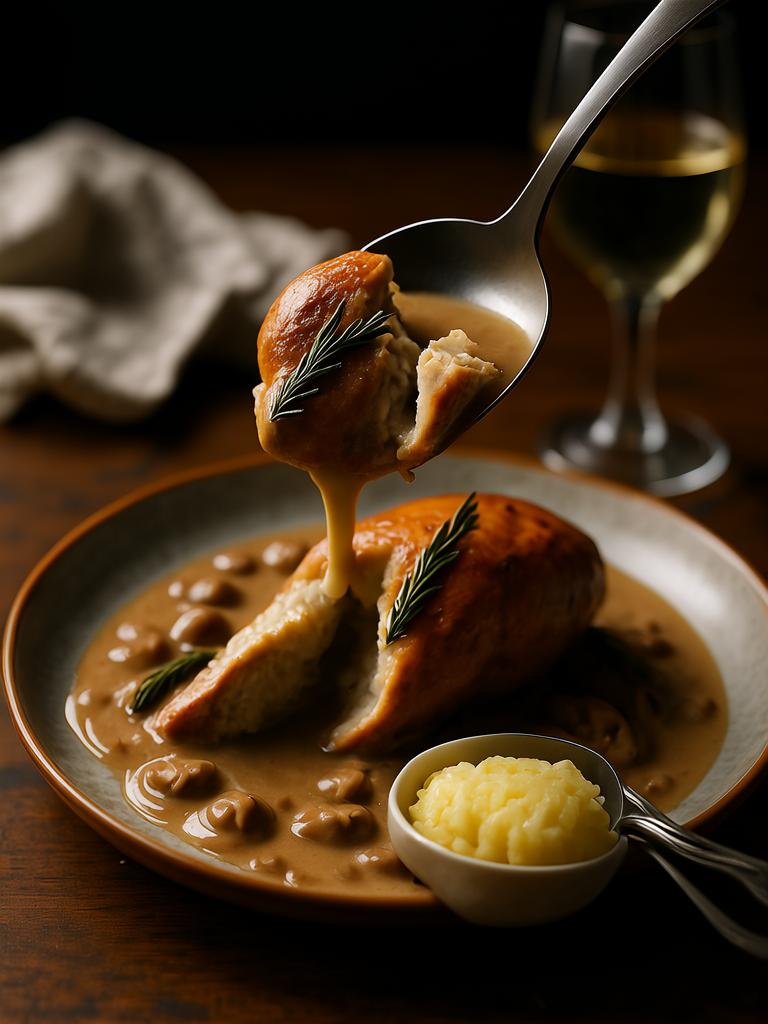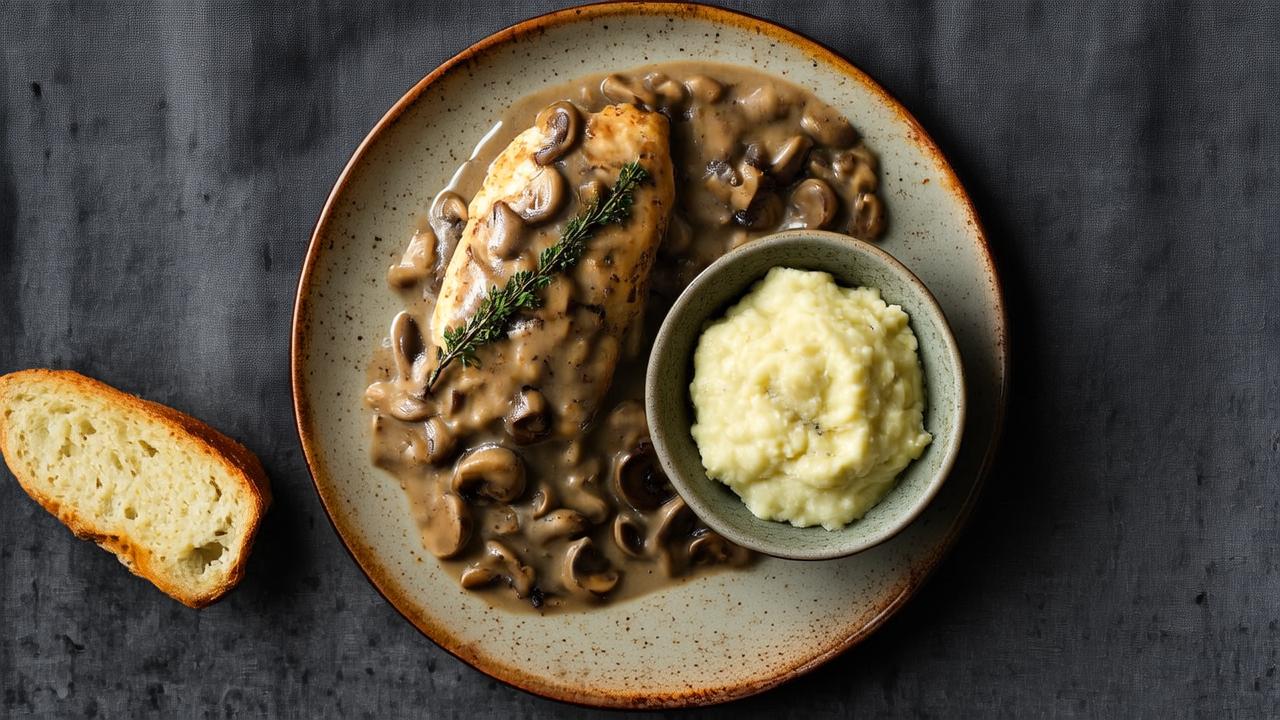Ever wonder why creamy mushroom chicken always feels like a hug in a bowl?
It’s the kind of dish chefs sneak bites of when no one’s watching. The moment the sauce hits the heat, garlic and mushrooms releasing their earthy perfume? It’s magic. But behind that magic is solid culinary science—and more than a little technique. Let’s break it down. This isn’t just comfort food. It’s a masterclass in balance, depth, and texture.
This dish, often brushed off as “simple,” is anything but when done properly. Professionals in the field know: achieving silky, glossy sauce without splitting, overcooking chicken, or drowning the umami in cream is an art. Done right, creamy mushroom chicken isn’t just dinner—it’s a showcase of restraint and richness all at once.
The Layers Behind the Cream
At first glance, it’s just cream and mushrooms, right? But no. The base of a good creamy sauce is about emulsification—fat suspended in liquid without breaking.
A mistake I’ve seen in too many commercial kitchens? Pouring cold cream into a scorching-hot pan. That’s a split sauce begging to happen. The key is to deglaze first—either with white wine, a splash of stock, or even a dash of sherry. Alcohols, when reduced, add complexity. Just make sure it’s fully evaporated. If your sauce smells like a bar, you didn’t reduce enough.
Now the cream. Heavy whipping cream—38% fat or more—is your friend. Lower fat options? Leave ’em for coffee. This isn’t a diet dish; it’s about mouthfeel. That’s why we don’t thicken with roux. The cream thickens on its own if reduced gently over time. If you’re in a rush and throw in flour, you’ve lost the game. Texture? Chalky. Flavor? Flat.
Let’s talk mushrooms.
Mushrooms Aren’t Just Mushrooms
Cremini, baby bellas, or if you’re lucky, king oysters—each brings something different to the pan.
Cremini have an earthy funk and stand up to heat. King oysters? Meaty, and they soak up sauce like sponges. Don’t just toss ’em in raw and hope for the best. Mushrooms need dry heat first. Throw them into a hot, dry pan—no oil yet—and let them release their moisture.
Once they’ve lost that initial water, then you hit ’em with butter or oil. That’s how you get that golden-brown edge. That’s flavor.
I once worked under a chef who’d scream if someone salted mushrooms too early. “You wanna steam ‘em?” he’d yell. Because salt draws out moisture. And moisture is the enemy of caramelization. Golden mushrooms = depth. Pale mushrooms = regret.

The Chicken: Texture, Timing, Technique
Now the protein.
You’ve got two options: boneless thighs or breasts. Thighs are forgiving. They stay moist even if your timing’s a bit off. But breast? Breast is brutal. One minute too long and you’re chewing on cotton.
Butterfly and flatten the breasts if you’re using them. That keeps cook time consistent. And season aggressively—salt, pepper, a little smoked paprika maybe.
Sear the chicken in a ripping hot pan. Don’t move it for the first few minutes. Let it crust. That crust is flavor. That crust is what turns a weekday dish into something memorable.
When done right, the chicken should have that deep golden hue on the outside and still be juicy at the center. Pull it just before it’s quite done and let it rest. Carryover heat will finish the job.
Deglazing: Flavor’s Forgotten Friend
Remember that fond? The golden-brown bits at the bottom of the pan? That’s concentrated umami. Don’t you dare wipe it away.
Deglaze with wine or stock. Use a wooden spoon and scrape like you mean it. That’s the backbone of your sauce. It tells a story—of heat, of browning, of patience.
Every bit of that sticky goodness should be in your final sauce. If not, you’re wasting flavor.
Building the Sauce
Once you’ve got your mushrooms and fond, toss in garlic—thin sliced, not minced. Mincing burns fast. And you want that garlic mellow and nutty, not acrid.
Add herbs. Thyme’s the classic here. Maybe a little rosemary if you’re brave. But not too much—it overpowers fast.
Deglaze. Then add your cream. Let it simmer, not boil. Reduce slowly. Stir often. Let the fat and liquid meld like old friends reuniting.
Once it’s nappe—the fancy word for “coats the back of a spoon”—you’re done.
Add the chicken back in, along with resting juices. Heat through, garnish with chopped parsley or chives, and serve hot.
Don’t Skip the Acid
Cream is rich. Mushrooms are heavy. Your palate needs a break. A squeeze of lemon? Essential. Maybe even a touch of Dijon mustard stirred in at the end. That zing balances everything.
Without acid, the sauce tastes muddy. With it? Clean, bright, complex.
Funny story—first time I made this for a private dinner client, they asked if I’d snuck in truffle. Nope. Just lemon zest. That’s how much of a lift acid can give.

What To Serve It With (And Why It Matters)
Creamy mushroom chicken begs for contrast. You want something to soak up the sauce without competing.
Mashed potatoes? Too soft on soft. Instead, go for:
- Buttered egg noodles – the classic. Slippery, but firm.
- Garlic roasted cauliflower – adds bite and bitterness.
- Herbed polenta – dreamy when creamy meets creamy, but only if you add enough salt.
Rice works too, but make it jasmine or basmati. Long grain for lightness.
Oh, and don’t forget the crunch. A simple salad, bitter greens, vinaigrette. That contrast keeps you coming back for bite after bite.
The Numbers: Why This Works
Professional kitchens care about margins. This dish works beautifully in restaurants because:
- Chicken thighs are cheap and forgiving.
- Cream is low-labor—sauce thickens as it reduces.
- Mushrooms add perceived luxury, even on a budget.
- Total prep/cook time: ~30-35 mins.
It plates well, photographs even better, and can sit in a bain-marie for service. Plus, it adapts—add bacon, sun-dried tomatoes, spinach, or even blue cheese if you’re bold.
Misconceptions (And Fixes)
“Cream sauces are heavy and boring.”
Not if balanced. Use acid. Use herbs. Don’t over-reduce.
“You need flour to thicken.”
Nope. Proper reduction + high-fat cream = perfect texture.
“Mushrooms are just filler.”
Used right, they’re the star. Brown ‘em well and they’ll outshine the meat.
Emerging Trends in Cream-Based Dishes
We’re seeing more chefs replace dairy cream with plant-based alternatives—cashew cream, oat milk, or coconut cream—for dietary flexibility.
But watch out: coconut changes the flavor dramatically. Cashew is closest in texture. If you’re swapping, taste constantly. And expect to rebalance seasoning, especially salt and acid.
Another trend? Infused oils. A drizzle of truffle oil or garlic-chili oil at the end can modernize the dish without altering the classic base.
Final Notes from the Line
Creamy mushroom chicken isn’t flashy. But it’s a test of fundamentals.
Can you sear right? Build flavor in layers? Finish sauce without breaking it?
Those are chef skills. Not TikTok tricks. Master this dish and you’ve mastered more than a recipe—you’ve mastered control.
So, next time someone calls this “basic,” smile. Then serve them a plate that shuts them up.
Because when it’s done right?
Creamy mushroom chicken sings.
Takeaways for the Pros
- Brown mushrooms dry first. Add fat later.
- Sear chicken hard, rest properly.
- Deglaze, don’t skip it.
- Reduce cream low and slow.
- Acid is your secret weapon.
- Balance texture—serve with contrast.
- Watch trends, but respect fundamentals.
Try it your way. Add wild mushrooms, hit it with tarragon, maybe even swap in rabbit for chicken.
But keep the heart of it intact. Rich, earthy, creamy—but never heavy.
Because the best dishes aren’t complicated. They’re confident.
And creamy mushroom chicken? It’s the quiet type that doesn’t need to shout.
It just… delivers.
FAQs
What type of mushrooms are best for creamy mushroom chicken?
Cremini, baby bella, or king oyster mushrooms work best for their depth and meaty texture.
Can I use chicken breast instead of thighs?
Yes, but breast dries out fast—flatten it and don’t overcook.
Why does my cream sauce split?
Usually from adding cold cream to a hot pan or boiling it too hard.
Do I need flour to thicken the sauce?
Nope—heavy cream thickens naturally when reduced slowly.
What can I substitute for dairy cream?
Use cashew cream or oat milk, but adjust seasoning for balance.
Is it okay to salt mushrooms early?
Not recommended—it pulls out moisture and prevents browning.
Can I skip the deglazing step?
No—deglazing lifts all the flavorful fond from the pan.
How do I avoid blandness in the final dish?
Add acid like lemon juice or Dijon to cut through richness.
What sides go best with this dish?
Buttered noodles, herbed polenta, or bitter green salad for contrast.
Can I make this ahead of time?
Yes—just reheat gently to avoid breaking the sauce.

Mariana is a passionate home cook who creates delicious, easy-to-follow recipes for busy people. From energizing breakfasts to satisfying dinners and indulgent desserts, her dishes are designed to fuel both your body and hustle.
When she’s not in the kitchen, she’s exploring new flavors and dreaming up her next recipe to share with the Foodie Hustle community.

